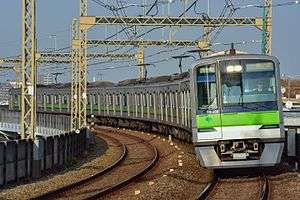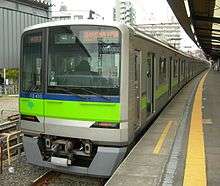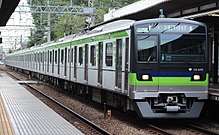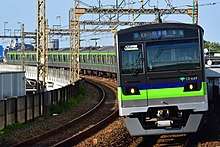Toei 10-300 series
| Toei 10-300 series | |
|---|---|
 8-car set 10-400 in December 2016 | |
| In service |
2005 – Present (10-300 series) 2005 – 2017 (10-300R series) |
| Manufacturer | JR East Niitsu, J-TREC, Tokyu Car |
| Replaced | Toei 10-000 series |
| Constructed | 2004– |
| Entered service | 2005– |
| Number built | 242 vehicles (27 sets) |
| Number in service | 210 vehicles (23 sets) |
| Number scrapped | 32 vehicles (4 sets) |
| Formation | 8/10 cars per set |
| Operator(s) | Toei Subway |
| Depot(s) | Oshima |
| Line(s) served | Toei Shinjuku Line, Keio Line, Keio Sagamihara Line |
| Specifications | |
| Car body construction | Stainless steel |
| Car length |
20,150 mm (66 ft 1 in) (end cars) 20,000 mm (65 ft 7 in) (intermediate cars) |
| Width | 2,770 mm (9 ft 1 in) |
| Height | 3,640 mm (11 ft 11 in) |
| Floor height | 1,130 mm (3 ft 8 in) |
| Doors | 4 pairs per side |
| Maximum speed | 120 km/h (75 mph) |
| Traction system |
Variable frequency (IGBT) (10-300 series) Chopper control (10-300R series) |
| Electric system(s) | 1,500 V DC |
| Current collection method | Overhead wire |
| Safety system(s) | ATC, Keio ATC, Keio ATS |
| Track gauge | 1,372 mm (4 ft 6 in) |
The Toei 10-300 series (東京都交通局10-300形) is an electric multiple unit (EMU) train type operated by the Tokyo subway operator Tokyo Metropolitan Bureau of Transportation (Toei) on the Toei Shinjuku Line in Tokyo, Japan since 2005.[1]
Overview
Based on the JR East E231 series design, the type consists of 10-300 series 8- and 10-car sets together with 10-300R series 8-car sets formed of refurbished 10-000 series intermediate cars sandwiched between newly built 10-300 series driving cars.[2] 3rd-batch trainsets based on the JR East E233-2000 series design were introduced from September 2013.
Operations
The 10-300 series and 10-300R series operate on the Toei Shinjuku Line between Shinjuku and Motoyawata, and also on inter-running services over the Keio Line from Shinjuku as far as Hashimoto on the Keio Sagamihara Line.[2]
Formations
As of 1 April 2017, the fleet consists of eight eight-car 10-300 series sets (10-370 to 10-440), and 15 ten-car 10-300 series sets (10-450 to 10-620), all based at Oshima Depot.[3]
10-300R series
The four eight-car 10-300R series sets (10-310 to 10-360) were formed as shown below with six motored (M) cars and two trailer (T) cars, and car 1 at the Shinjuku end.[4]
| Car No. | 1 | 2 | 3 | 4 | 5 | 6 | 7 | 8 |
|---|---|---|---|---|---|---|---|---|
| Designation | Tc2 | M2' | M1 | M2 | M1 | M2 | M1 | Tc1 |
| Numbering | 10-xx9 | 10-xx8 | 10-xx7 | 10-xx6 | 10-xx5 | 10-xx2 | 10-xx1 | 10-xx0 |
- "xx" corresponds to the set number.
- Cars 3 and 7 were each fitted with two lozenge-type pantographs, and car 5 had one.[4]
10-300 series 8-car sets

The eight 8-car 10-300 series sets (10-370 to 10-440) are formed as shown below with five motored (M) cars and three trailer (T) cars, and car 1 at the Shinjuku end.[3]
| Car No. | 1 | 2 | 3 | 4 | 5 | 6 | 7 | 8 |
|---|---|---|---|---|---|---|---|---|
| Designation | Tc2 | M2 | M1 | T | M1 | M2 | M1 | Tc1 |
| Numbering | 10-xx9 | 10-xx8 | 10-xx7 | 10-xx6 | 10-xx5 | 10-xx2 | 10-xx1 | 10-xx0 |
- "xx" corresponds to the set number.
- Cars 3 and 7 are each fitted with two single-arm pantographs, and car 5 has one.[3]
10-300 series 10-car sets
The four 10-car 10-300 series sets (10-450 to 10-480) are formed as shown below with six motored (M) cars and four trailer (T) cars, and car 1 at the Shinjuku end.[3][5]
| Car No. | 1 | 2 | 3 | 4 | 5 | 6 | 7 | 8 | 9 | 10 |
|---|---|---|---|---|---|---|---|---|---|---|
| Designation | Tc2 | M2 | M1 | T1 | M1 | M1 | T1 | M2 | M1 | Tc1 |
| Numbering | 10-xx9 | 10-xx8 | 10-xx7 | 10-xx6 | 10-xx5 | 10-xx4 | 10-xx3 | 10-xx2 | 10-xx1 | 10-xx0 |
| Weight (t) | 27.2 | 29.3 | 30.2 | 23.8 | 29.3 | 28.6 | 23.8 | 29.4 | 30.1 | 27.1 |
| Capacity (total/seated) | 140/45 | 149/51 | 148/54 | 148/54 | 148/54 | 148/54 | 148/54 | 148/54 | 149/51 | 136/45 |
- "xx" corresponds to the set number.
- Cars 3, 5, and 9 are each fitted with two T-PT7154-A single-arm pantographs.[3]
3rd-batch 10-300 series 10-car sets

The 3rd-batch 10-300 series sets (10-490 to 10-510) delivered from 2013 are formed as shown below with six motored (M) cars and four trailer (T) cars.[6]
| Car No. | 1 | 2 | 3 | 4 | 5 | 6 | 7 | 8 | 9 | 10 |
|---|---|---|---|---|---|---|---|---|---|---|
| Designation | Tc9 | M8 | M7 | T6 | T5 | M4 | M3 | M2 | M1 | Tc0 |
| Numbering | 10-xx9 | 10-xx8 | 10-xx7 | 10-xx6 | 10-xx5 | 10-xx4 | 10-xx3 | 10-xx2 | 10-xx1 | 10-xx0 |
| Weight (t) | 29.4 | 31.0 | 31.3 | 25.2 | 25.2 | 28.0 | 31.3 | 31.0 | 31.3 | 29.4 |
| Capacity (total/seated) | 132/45 | 145/51 | 144/54 | 144/54 | 144/54 | 144/54 | 144/54 | 144/54 | 145/51 | 132/45 |
- "xx" corresponds to the set number.
- Cars 3, 7, and 9 are each fitted with two T-PT7154-A single-arm pantographs.[3]
4th-batch 10-300 series 10-car sets
Three fourth-batch 10-car sets were introduced from May 2015. These sets differ from earlier built sets by the addition of a light green stripe running alongside the bodies, including on the doors.[7] The fourth-batch sets (10-520 onward) are formed as shown below with six motored (M) cars and four trailer (T) cars.[8]
| Car No. | 1 | 2 | 3 | 4 | 5 | 6 | 7 | 8 | 9 | 10 |
|---|---|---|---|---|---|---|---|---|---|---|
| Designation | Tc9 | M8 | M7 | T6 | T5 | M4 | M3 | M2 | M1 | Tc0 |
| Numbering | 10-xx9 | 10-xx8 | 10-xx7 | 10-xx6 | 10-xx5 | 10-xx4 | 10-xx3 | 10-xx2 | 10-xx1 | 10-xx0 |
| Weight (t) | 29.4 | 31.0 | 31.3 | 25.2 | 25.2 | 28.0 | 31.3 | 31.0 | 31.3 | 29.4 |
| Capacity (total/seated) | 132/45 | 145/51 | 144/54 | 144/54 | 144/54 | 144/54 | 144/54 | 144/54 | 145/51 | 132/45 |
- "xx" corresponds to the set number.
- Cars 3, 7, and 9 are each fitted with two single-arm pantographs.[8]
Interior
1st/2nd batch sets
Passenger accommodation consists of longitudinal bench seating with individually sculpted seats covered with green moquette.[1] Passenger information is provided by LED scrolling displays above the doorways.[1]
 Interior view in April 2010
Interior view in April 2010 Interior of later-build car inserted into 10-car sets in August 2010
Interior of later-build car inserted into 10-car sets in August 2010- Seating in October 2007
- Wheelchair space in October 2007
- Priority seat in October 2007
3rd-batch sets
 Interior view in October 2013
Interior view in October 2013 7-person bench seat in October 2013
7-person bench seat in October 2013 Wheelchair space in October 2013
Wheelchair space in October 2013 Priority seat in October 2013
Priority seat in October 2013
4th-batch sets
Three fourth-batch sets have two LCD passenger information screens above each doorway.[7]
History
Twelve eight-car 10-300 series sets (96 vehicles) were built between 2004 and 2006 to replace the older (1st and 2nd batch) 10-000 series sets dating from the late 1970s.[1] These were designed to be lengthened to ten-car sets in the future with the insertion of additional motored and trailer cars as cars 3 and 4.[1] The majority of the sets were built by Tokyu Car Corporation (now J-TREC) in Yokohama, but the intermediate cars of the three sets 10-450 to 10-470 were built at JR East's Niitsu factory in Niigata Prefecture, and these were transferred to Tokyu Car's Yokohama factory in two batches in January and February 2006 to be incorporated into the completed sets.[1] The first set, 10-370, was delivered in November 2004 for night-time testing of the new D-ATC signalling system.[1] The first sets entered revenue service on 21 May 2005.[1]
The six eight-car 10-300R series sets were created in 2005 and 2006 by adding new 10-300 series driving cars built by Tokyu Car sandwiching three pairs of refurbished 10-xx7 and 10-xx8 cars from former 10-000 series sets 10-010 to 10-180.[1]
The newly formed ten-car sets (10-450 to 10-480) entered revenue service from 1 June 2010.[2] Lengthening from eight to ten cars involved inserting new 2nd-batch "10-4x3" (T1) trailer cars and "10-4x5" (M1) motored cars, and renumbering the original "10-4x5" cars to "10-4x4" as well as removing the original pantograph.[9]
A further three new ten-car 3rd-batch sets were delivered during 2013.[9] The first, set 10-490, entered revenue service on 15 September 2013.[10] These sets are based on the JR East E233 series design.[3]

The last remaining 10-300R series set in service, set 10-330, was withdrawn following its final run on 14 February 2017.[11]
Build histories

The build histories of the 10-300 series sets are as follows.[3][9]
| Set No. | Manufacturer | Build year | Notes |
|---|---|---|---|
| 10-370 | Tokyu Car, Yokohama | 14 May 2005 | 1st batch |
| 10-380 | Tokyu Car, Yokohama | 16 May 2005 | |
| 10-390 | Tokyu Car, Yokohama | 16 June 2005 | |
| 10-400 | Tokyu Car, Yokohama | 23 July 2005 | |
| 10-410 | Tokyu Car, Yokohama | 1 September 2005 | |
| 10-420 | Tokyu Car, Yokohama | 29 September 2005 | |
| 10-430 | Tokyu Car, Yokohama | 24 November 2005 | |
| 10-440 | Tokyu Car, Yokohama | 22 December 2005 | |
| 10-450 | Tokyu Car/Niitsu | 7 April 2006 | |
| 10-460 | Tokyu Car/Niitsu | 27 April 2006 | |
| 10-470 | Tokyu Car/Niitsu | 23 June 2006 | |
| 10-480 | Tokyu Car/Niitsu | 13 July 2006 | |
| 10-490 | J-TREC, Yokohama | 7 August 2013 | 3rd batch |
| 10-500 | J-TREC, Yokohama | 30 October 2013 | |
| 10-510 | J-TREC, Yokohama | 3 December 2013 | |
| 10-520 | J-TREC, Yokohama | 13 May 2015 | 4th batch |
| 10-530 | J-TREC, Yokohama | 10 June 2015 | |
| 10-540 | J-TREC, Yokohama | 1 July 2015 | |
| 10-550 | J-TREC, Yokohama | 28 April 2016 | 5th batch |
| 10-560 | J-TREC, Yokohama | 31 May 2016 | |
| 10-570 | J-TREC, Yokohama | 28 June 2016 | |
| 10-610 | J-TREC, Yokohama | 28 July 2016 | |
| 10-620 | J-TREC, Yokohama | 7 September 2016 | |
| 10-630 | J-TREC, Yokohama | 2 August 2017[12] | |
| 10-640 | J-TREC, Yokohama | 6 September 2017[12] |
References
- 1 2 3 4 5 6 7 8 9 Kajiwara, Hisashi (July 2009). 公営地下鉄在籍両数ビッグ3 東京都交通局 [Top 3 Subway Vehicle Owners: Toei]. Japan Railfan Magazine (in Japanese). Vol. 49 no. 579. Japan: Koyusha Co., Ltd. pp. 135–137.
- 1 2 3 私鉄車両編成表 2012 [Private Railway Rolling Stock Formations - 2012]. Japan: JRR. July 2012. p. 40. ISBN 978-4-330-29911-2.
- 1 2 3 4 5 6 7 8 私鉄車両編成表 2017 私鉄車両編成表 2017 [Private Railway Rolling Stock Formations - 2017] (in Japanese). Japan: Kotsu Shimbunsha. 25 July 2017. p. 32. ISBN 978-4-330-81317-2.
- 1 2 私鉄車両編成表 2016 [Private Railway Rolling Stock Formations - 2016] (in Japanese). Japan: Kotsu Shimbunsha. 25 July 2016. p. 32. ISBN 978-4-330-70116-5.
- ↑ 東京都交通局10-300形 10両編成化 [Toei 10-300 series lengthening to 10 cars]. Japan Railfan Magazine (in Japanese). Vol. 51 no. 603. Japan: Koyusha Co., Ltd. July 2011. pp. 92–94.
- ↑ 東京都交通局10-300形 3次車 [Toei 10-300 series 3rd-batch sets]. Japan Railfan Magazine (in Japanese). Vol. 53 no. 632. Japan: Koyusha Co., Ltd. December 2013. pp. 56–57.
- 1 2 10‐300形10‐520編成が営業運転を開始 [10-300 series set 10-520 enters revenue service]. Japan Railfan Magazine Online (in Japanese). Japan: Koyusha Co., Ltd. 23 May 2015. Retrieved 23 May 2015.
- 1 2 東京都交通局10-300形 4次車 [Toei 10-300 series 4th-batch sets]. Japan Railfan Magazine (in Japanese). Vol. 55 no. 652. Japan: Koyusha Co., Ltd. August 2015. p. 71.
- 1 2 3 Konoda, Tsuneo (February 2018). 都営地下鉄新宿線の車両たち 前編 [Rolling Stock of the Toei Subway Shinjuku Line (Part 1)]. Japan Railfan Magazine (in Japanese). Vol. 58 no. 682. Japan: Koyusha Co., Ltd. p. 85-87.
- ↑ 都交10-300形3次車が営業運転を開始 [Toei 10-300 series 3rd-batch set enters revenue service]. Japan Railfan Magazine Online (in Japanese). Japan: Koyusha Co., Ltd. 18 September 2013. Retrieved 18 September 2013.
- ↑ 【東京都】10-300R形 引退する [Toei 10-300R series withdrawn]. RM News (in Japanese). Japan: Neko Publishing Co., Ltd. 15 February 2017. Archived from the original on 15 February 2017. Retrieved 15 February 2017.
- 1 2 私鉄車両のうごき [Private railway rolling stock changes]. Tetsudo Daiya Joho Magazine (in Japanese). Vol. 47 no. 405. Japan: Kotsu Shimbun. January 2018. p. 106.
External links
| Wikimedia Commons has media related to Toei 10-300 series. |
- Toei 10-300 series (Japan Railfan Magazine) (in Japanese)